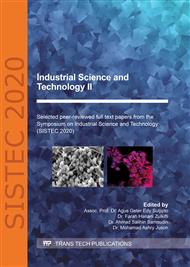p.224
p.230
p.236
p.242
p.247
p.252
p.259
p.265
p.273
GC-MS Analysis and In Vitro Antioxidant Activity of Crude Extracts and Different Fractions of Moringa Oleifera Pods
Abstract:
Moringa oleifera (M. oleifera) has been known as a medicinal plant. The objectives of this study is to identify the chemical compositions of M. oleifera pods extracts and to evaluate its total phenolic content (TPC) and antioxidant activity. The methodology of this study began with the collection of the pod's sample, drying and grinding the pods into powdered form. M. oleifera pods extracts were prepared by using methanol (MeOH), hexane, dichloromethane (DCM), and ethyl acetate (EtOAc) solvent which yielded respective residues. All extracts were subjected to Gas Chromatography-Mass Spectrometry (GC-MS) to identify its chemical compositions. Major compound found in hexane, DCM, EtOAc, and MeOH extracts were nonanoic acid (30.94 %), diisooctyl phthalate (89.45 %), benzoic acid, 4-hydroxy- (37.57 %) and octanoic acid (19.19 %), respectively. The TPC quantification was done via Folin-Ciocalteu method showed that EtOAc extract has the highest phenols content with 500.05 mg GAE/g. Generally, all extract contain moderate phenolic content. M. oleifera pods extracts were screened for the antioxidant activity via 2,2-diphenyl-1-picrylhydrazyl (DPPH) free radical. Hexane, DCM and EtOAc extracts exhibited good free radical scavenging activity with IC50 of 65.79 μg/mL, 74.93 μg/mL and 82.83 μg/mL, respectively. MeOH showed the lowest free radical scavenging activity with IC50 529.6 μg/mL. However, antioxidant activity of all extracts was low compared to standard, ascorbic acid (AA) with IC50 of 19.57 μg/mL. The presence of various bioactive constituents in the M. oleifera pods extracts might contributed to the antioxidant activity of the plant.
Info:
Periodical:
Pages:
247-251
Citation:
Online since:
March 2021
Authors:
Keywords:
Price:
Сopyright:
© 2021 Trans Tech Publications Ltd. All Rights Reserved
Share:
Citation:


